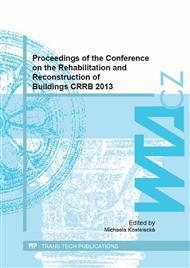[1]
Viitanen H. Factors affecting the development of mould and brown rot decay in wooden material and wooden structures - effect of humidity, temperature and exposure time. Uppsala: Swedish University of Agricultural Sciences, (1996).
Google Scholar
[2]
Griffin, D.M. Water potential and wood-decay fungi. Annual Rev. Phytopathology 15: 19-29, (1977).
Google Scholar
[3]
Viitanen H. Factors affecting the development of biodeterioration in wooden material and wooden constructions. Materials and Structures 27: 483-493, (1994).
DOI: 10.1007/bf02473453
Google Scholar
[4]
Bravery, A.F., Berry, R.W., Carey, J.K., Cooper, D. E. Recognising Wood Rot and Insect Damage in Buildings, Building Research Establishment, 1992, 114 pages.
Google Scholar
[5]
Micales, J.A., Highley, T.L. Physiological characteristic of a non-degradative isolate of Postia (=Poria) placenta. Mycologia, 81, 205-215, (1989).
DOI: 10.1080/00275514.1989.12025649
Google Scholar
[6]
Green, F., Highley, T. L. Mechanism of Brown-Rot Decay: Paradigm or Paradox, International Biodeterioration & Biodegradation 29(2-3) 113-124, (1997).
DOI: 10.1016/s0964-8305(96)00063-7
Google Scholar
[7]
Cowling, E.B. Comparative biochemistry of decay of sweetgum sapwood by white-rot and brown-rot Fungi, U. S: Dep. Agric. Techn. Bull. No. 1258. 1-75, (1961).
Google Scholar
[8]
Kirk, T.K., Ibach, R., Mozuch, M., Conner, A., Highley, T.L. Characteristics of cotton cellulose depolymerized by a brown-rot fungus, by acid, or by chemical oxidants. Holzforschung 45: 239-244, (1991).
DOI: 10.1515/hfsg.1991.45.4.239
Google Scholar
[9]
Kleman-Leyer, K., Agosin, E., Conner, A., Kirk, K. Changes in molecular size distribution of cellulose during attack by white-rot and brown-rot fungi. Applied and Environmental Microbiol. 58: 1266-1270, (1992).
DOI: 10.1128/aem.58.4.1266-1270.1992
Google Scholar
[10]
Wilcox, W.W. Review of literature on the effect of early stages of decay on wood strength. Wood and Fiber, 9 (4), 252-257, (1978).
Google Scholar
[11]
Toole, E. R. Reduction in crushing strength and weight associated with decay by rot fungi. Wood Science, 3 (3), 172-178, (1971).
Google Scholar
[12]
Mizumoto, S. The effect of decay caused by Gloeophyllum trabeum on the strength properties of Japanese red pine sapwood. Journal of the Japanese Forestry Society, 48 (1), 7-11, (1965).
Google Scholar
[13]
Highly, T.L. Requirements for cellulose degradation by a brown-rot fungus. Material und Organismen 12: 25-36, (1977).
Google Scholar


